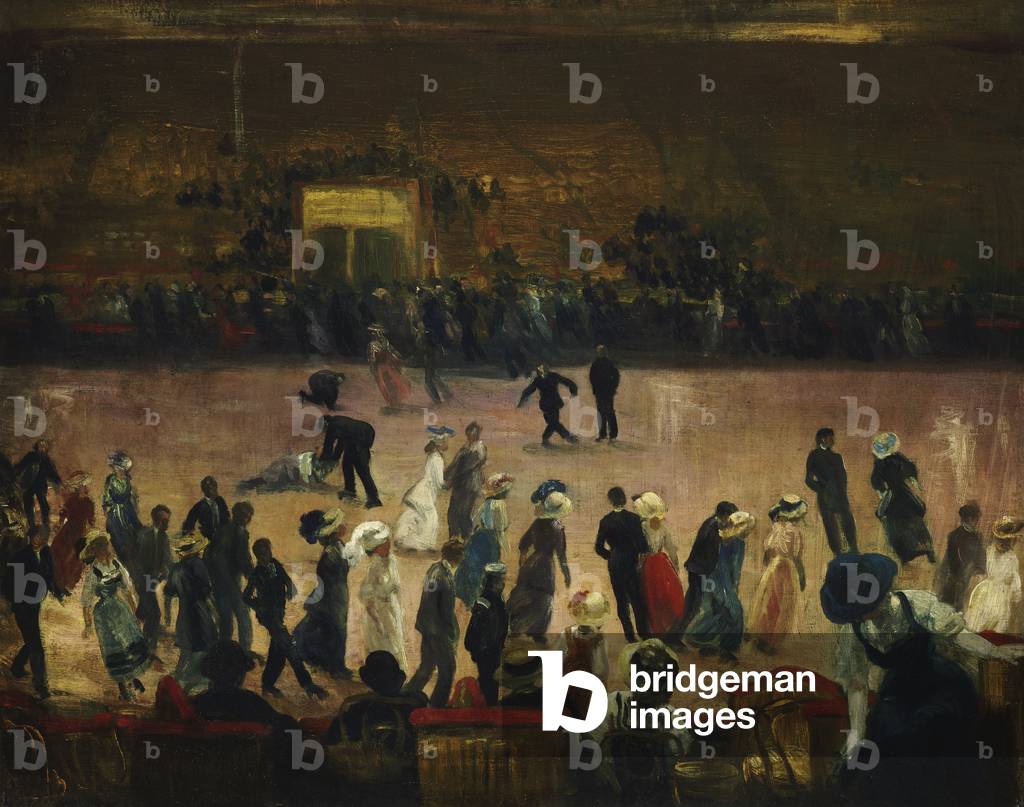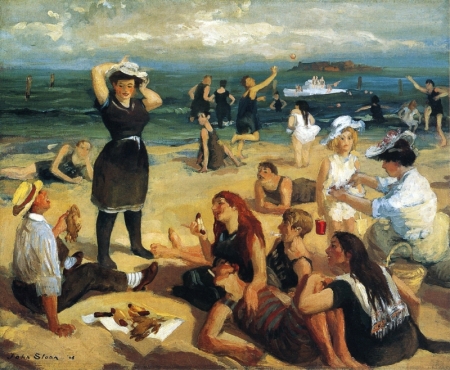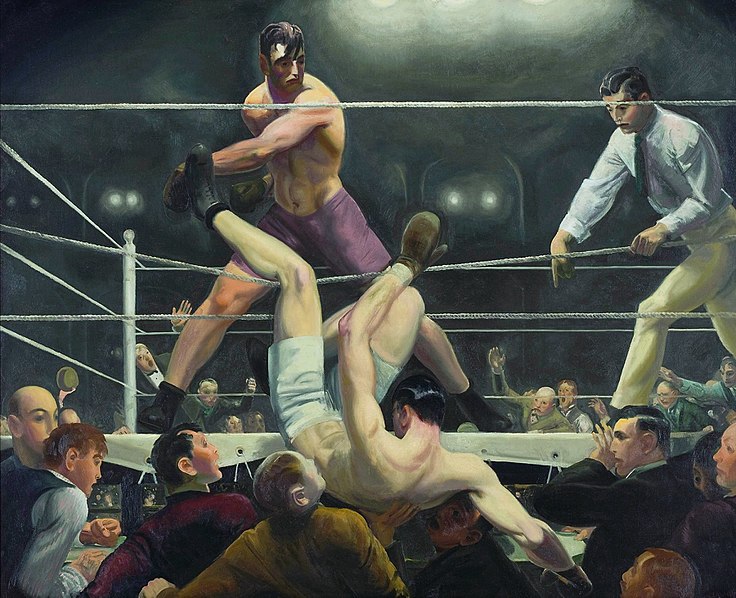This exhibition brought together paintings depicting vibrant and diverse leisure activities experienced and observed by members of the Ashcan school. The Ashcan school artists, often associated with Robert Henri’s circle of artists, showed the lower levels of the socio-economic scale who lived and toiled in turn of the century New York. Henri encouraged his followers to capture the world as they found it, to absorb “the great ideas native to his country.” Among the subjects they addressed were the multitude of leisure activities available to the people of varied social strata. Organized by the Detroit Institute of Arts.
While the Ashcan school is most commonly associated with gritty depictions of working class life in turn-of-the-century New York, Life’s Pleasures focuses on a lesser-known aspect of their production: the celebration of leisure activities observed and enjoyed by the artists and their friends. Robert Henri encouraged his followers to “Paint what you see. Paint what is real.” Among the topics chosen therefore were the multitude of pleasurable pastimes available to citizens of all social levels. Noted for quick brushstrokes, saturated color palettes and thickly layered paint (impasto), these paintings celebrated the joie de vivre that the artists encountered in the world around them.
“From a theatrical production, a day at the beach or a boxing match, Ashcan painters were dedicated to exploring everyday American life at the turn of the century,” says Katie Delmez, curator at the Frist Center. “Artists depicting a beach scene, for example, were not attempting to capture the effect of light as were painters of an earlier generation; but rather hoping to depict an array of people escaping the crowded city and simply enjoying a leisurely day off.”
The Ashcan School
When Robert Henri returned to Philadelphia in 1891 after traveling through Europe, he befriended a group of newspaper illustrators working at the Philadelphia Press—William Glackens, George Luks, Everett Shinn and John Sloan. Henri convinced these young men to leave the paper and take up painting as a serious profession. Their work in the news industry, which entailed documenting city events as they personally witnessed them, made the artists receptive to Henri’s call to create an “art for life.” In 1900, Henri moved to New York City and encouraged the other artists to do the same. Eight years later, these five artists joined with Maurice Prendergast, Ernest Lawson and Arthur B. Davies to mount an important but controversial independent exhibition at the Macbeth Gallery. The Eight, as they were called, were reacting against the more conservative National Academy of Design. Henri and his broadening circle of students—eventually referred to as the Ashcan school—cared little for the polished techniques and polite subject matter of the academicians; instead, they documented everyday urban life with an energetic freedom of spirit.
Life’s Pleasures: The Ashcan Artists’ Brush with Leisure, 1895–1925 was presented in four major sections: The Fine and Performing Arts; Sports and Recreation; Bars and Cafés: At Home and Abroad; and The Outdoors: Park, Beaches, and the Country.
The Fine and Performing Arts:
With New York City’s thriving cultural life, the artists immersed themselves in the city’s offerings, attending art openings, theatrical plays, musical concerts and dance performances. Popular and less expensive events, such as circuses and carnivals, captured the imagination of the Ashcan school as well with their bright lights and sense of excitement.
The artists were interested in all aspects of these forms of entertainment: the skill of the performers, dramatic stage effects, watching others enjoying a spectacle, and the thrill of being part of the audience themselves. Everett Shinn, George Luks and William Glackens at times even participated in amateur theater productions. Several members of Henri’s circle also socialized with the city’s cultural elite and included them in their paintings.
Exhibition highlights in this section included the iconic painting

Hammerstein’s Roof Garden (ca. 1901) by William Glackens,
Theatre Scene (ca. 1906) by Everett Shinn, and

Salome (1909) by Robert Henri.
Sports and Recreation:
Sports were an increasingly popular part of American leisure life. The first modern Olympic Games were held in 1896, and spectator events began to draw larger audiences. Attaining good health through exercise was part of the progressive thinking of the time. While athletics were still dominated by men, there were increasing opportunities for women to participate, especially for those who considered themselves to be “modern.”
Part of the Ashcan group’s ethos was to be active and “manly,” and most of the artists were both sports participants and spectators. They were interested in a broad variety of athletic endeavors—from the highly charged masculine sports of boxing and wrestling matches, to the popular activities of swimming and roller skating, to the more genteel diversions of horseback riding, tennis and croquet.
Exhibition highlights included

Skating Rink, New York City (1906) by William Glackens and

Club Night (1907) by George Bellows.
Bars and Cafés: At Home and Abroad:
Socializing outside the home was becoming an important part of a New Yorker’s social life, and dining out in the city was a popular activity for those who could afford it. In keeping with the practice of capturing their own life experiences, the Ashcan school created many images of the cafés and restaurants that they frequented, often including their friends and themselves in the scenes.
After New York City, Paris was the most important and inspiring city for the Ashcan artists. At the turn of the 20th century, Europeans and Americans alike saw the French capital as the center of art and culture. Robert Henri studied in Paris and encouraged his students to do the same. While there, the young artists eagerly embraced the city and the lively social interaction found in its many cafés.
The exhibition featured the paintings of

The Café Francis (ca. 1906) by George Luks and

New York City’s famed McSorley’s Bar (1912) by John Sloan.
The Outdoors: Park, Beaches, and the Country:
In the densely populated New York City, outdoor areas became important focal points for leisure activities. Parks provided an oasis of nature and open space within the congested urban environment. Central Park in particular was a place where Ashcan artists went to both observe and participate in such activities as picnicking, ice-skating, lawn games and simply relaxing. The development of public transportation, especially the subway, facilitated access to these parks as well as travel to outlying areas. Public beaches, pleasure parks such as Coney Island, and the countryside also offered temporary escape from the city. Members of the lower classes, primarily located in the southern part of Manhattan, often found relief from crowded conditions along the river piers, where they fished and swam.
Highlights from this section were

South Beach Bathers (1907–08) by John Sloan and
.jpg/798px-George_Bellows_-_A_Day_in_June_(1913).jpg)
A Day in June (1913) by George Bellows.
Venues:
Frist Center for the Visual Arts
Nashville, Tennessee
August 3–October 28, 2007
New York Historical Society
New York, New York
November 18, 2007–February 10, 2008
Detroit Institute of Arts
March 2, 2008-May 25, 2008
More Images:

Central Park, Winter
by William Glackens, ca. 1905, oil, 25 x 30. Collection The Metropolitan Museum of Art, New York, New York.

Chez Mouquin
by William Glackens, 1905, oil, 48½ x 39. Collection The Art Institute of Chicago, Chicago, Illinois.

Dempsey and Firpo
by George Bellows 1924 Whitney Museum of American Art, New York
Catalogue:

The images that are often associated with the Ashcan school of artists are the more sombre depictions of working-class life in early twentieth-century New York. This subject matter is not, however, representative of the entire spectrum of Ashcan art. Featuring some of the Ashcan school's most vibrant and outstanding works, this book demonstrates unequivocally the zeal with which these artists and their circle embraced the world of play enjoyed by all levels of society. Spirited scenes of diverse leisure activities in cafés, bars and parks, at the theatre, on the beach, at sporting events and in the countryside provide a refreshing look at this important artistic movement.
Features works by the Ashcan artists and their circle, including George Bellows (on cover), William Glackens, Robert Henri, Edward Hopper, Rockwell Kent, George Luks, Guy Pène du Bois, Maurice Prendergast, Everett Shinn and John Sloan, among others; omplemented by lively essays on the world of leisure experienced and depicted by the Ashcan school.